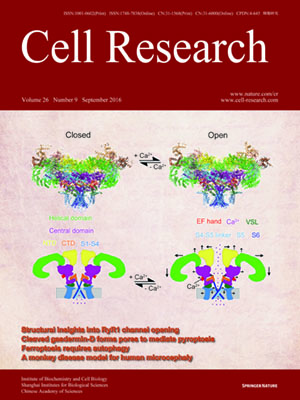
Volume 26, No 9, Sep 2016
ISSN: 1001-0602
EISSN: 1748-7838 2018
impact factor 17.848*
(Clarivate Analytics, 2019)
Volume 26 Issue 9, September 2016: 1033-1047
ORIGINAL ARTICLES
Cortical neurons gradually attain a post-mitotic state
Froylan Calderon de Anda1,2,3, Ram Madabhushi2, Damien Rei2, Jia Meng2,4, Johannes Gräff2,5, Omer Durak2, Konstantinos Meletis2,6, Melanie Richter1, Birgit Schwanke1, Alison Mungenast2 and Li-Huei Tsai2
1Center for Molecular Neurobiology Hamburg (ZMNH), University Medical Center Hamburg-Eppendorf, 20251 Hamburg, Germany;
2Department of Brain and Cognitive Sciences, Picower Institute for Learning and Memory, Massachusetts Institute of Technology, 77 Massachusetts Avenue, Building 46, Room 4235A, Cambridge, MA 02139, USA.
3Present address: Center for Molecular Neurobiology Hamburg (ZMNH), University Medical Center Hamburg-Eppendorf, 20251 Hamburg, Germany
4Department of Biological Sciences Xi'an Jiaotong-Liverpool University, 111 Renai Road, SIP Suzhou, Jiangsu 215123, China
5Brain Mind Institute, School of Life Sciences, Ecole Polytechnique Fédérale de Lausanne (EPFL), Bâtiment AI 2137.1, CH-1015 Lausanne, Switzerland
6Department of Neuroscience, Karolinska Institutet, Retzius väg 8, S-17177 Stockholm, Sweden
Correspondence: Froylan Calderon de Anda, Tel: +49-40-7410-56817; Fax: +49-40-7410-56450(froylan.calderon@zmnh.uni-hamburg.de)
Once generated, neurons are thought to permanently exit the cell cycle and become irreversibly differentiated. However, neither the precise point at which this post-mitotic state is attained nor the extent of its irreversibility is clearly defined. Here we report that newly born neurons from the upper layers of the mouse cortex, despite initiating axon and dendrite elongation, continue to drive gene expression from the neural progenitor tubulin α1 promoter (Tα1p). These observations suggest an ambiguous post-mitotic neuronal state. Whole transcriptome analysis of sorted upper cortical neurons further revealed that neurons continue to express genes related to cell cycle progression long after mitotic exit until at least post-natal day 3 (P3). These genes are however down-regulated thereafter, associated with a concomitant up-regulation of tumor suppressors at P5. Interestingly, newly born neurons located in the cortical plate (CP) at embryonic day 18-19 (E18-E19) and P3 challenged with calcium influx are found in S/G2/M phases of the cell cycle, and still able to undergo division at E18-E19 but not at P3. At P5 however, calcium influx becomes neurotoxic and leads instead to neuronal loss. Our data delineate an unexpected flexibility of cell cycle control in early born neurons, and describe how neurons transit to a post-mitotic state.
10.1038/cr.2016.76
FULL TEXT | PDF
Browse 2144


